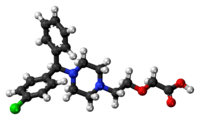Levocetirizine
 | |
 | |
| Clinical data | |
|---|---|
| Trade names | Xyzal, Levazyr |
| AHFS/Drugs.com | Monograph |
| MedlinePlus | a607056 |
| Pregnancy category |
|
| Routes of administration | By mouth |
| ATC code | |
| Legal status | |
| Legal status | |
| Pharmacokinetic data | |
| Bioavailability | High |
| Protein binding | 90% |
| Metabolism | Hepatic 14% CYP3A4 |
| Elimination half-life | 6 to 10 hours |
| Excretion | Renal and fecal |
| Identifiers | |
| |
| CAS Number | |
| PubChem CID | |
| IUPHAR/BPS | |
| ChemSpider | |
| UNII | |
| KEGG | |
| ChEMBL | |
| Chemical and physical data | |
| Formula | C21H25ClN2O3 |
| Molar mass | 388.888 g/mol |
| 3D model (JSmol) | |
| |
| |
| | |
Levocetirizine (as levocetirizine dihydrochloride) is a third-generation,[1] non-sedating antihistamine, developed from the second-generation antihistamine cetirizine. Chemically, levocetirizine is simply the isolated levorotary enantiomer of cetirizine, which is sold as a racemic mixture.
Medical uses
Levocetirizine is used for allergy symptoms including watery eyes, runny nose, sneezing, hives, and itching.[2] The manufacturers claim it to be more effective with fewer side effects than previous second-generation drugs; however, there have been no published independent studies supporting these comparative assertions. A study part-funded by the manufacturer UCB concluded it may be more effective than some other second- and third-generation anti-histamines, but did not compare it to cetirizine.[3]
Side effects
Levocetirizine is called a non-sedating antihistamine as it does not enter the brain in significant amounts, and is therefore unlikely to cause drowsiness. Cardiac safety with repolarization may be better than some other antihistamines, as levocetirizine does not significantly prolong the QT Interval in healthy individuals.[4][5][6] However, some people may still experience some slight sleepiness, headache, mouth dryness, lightheadedness, vision problems (mainly blurred vision), palpitations and fatigue.[7]
Pharmacology
Levocetirizine is an antihistamine. It acts as an inverse agonist that decreases activity at histamine H1 receptors. This in turn prevents the release of other allergy chemicals and increase the blood supply to the area, and provides relief from the typical symptoms of hay fever.
Chemistry
Chemically, levocetirizine is the active levorotary enantiomer of cetirizine, also called the l-enantiomer of cetirizine. It is a member of the diphenylmethylpiperazine group of antihistamines.
History
Levocetirizine was first launched in 2001 by Belgian pharmaceutical company UCB.
Society and culture
Availability
On 31 January 2017, the Food and Drug Administration approved Xyzal as an over-the-counter drug.[8] Although the drug was only authorized by the FDA on 25 May 2007, it was already available in most European countries. Like many new drugs it entered the market at a higher price than currently available third and second generation antihistamines. In India, one form of the drug is available as Crohist MK tablets and syrup, a formulation of levocetirizine hydrochloride and montelukast. In India, Crohist MK is a Schedule 'H' drug and may only be prescribed by a registered medical practitioner.
Brand names
Levocetirizine is sold under the following brand names:
- Xyzal /ˈzaɪˌzɑːl/ in Australia, Austria, Bulgaria, Croatia, Czech Republic, Finland, France, India, Ireland (also Rinozal), Italy, Lithuania, Netherlands, Poland, Portugal, Romania, Taiwan, Thailand, Turkey, The Philippines, Serbia, Singapore, Slovakia, Slovenia, South Africa and UK. On May 25, 2007, the United States Food and Drug Administration approved Xyzal, where it is co-marketed by Sanofi-Aventis.
- Xusal in Germany
- Xozal in Greece
- Xazal in Spain
- Xuzal in Mexico
- In Hungary it is marketed as Zilola (made by Richter Gedeon) and Histisynt (Actavis).
- In India, levocetirizine is marketed by GlaxoSmithKline under the brand name Vozet. Torrent Pharma launched UVNIL for the rural market. Kaptab Pharmaceuticals markets a mouth dissolving form in India.
- In Pakistan levocetirizine was first launched in a liquid formulation by Novartis Consumer Health Division under the name of T-Day Syrup.
- In Nepal levocetirizine is available in tablets with the brand name Curin manufactured by Beximco Pharma.[9]
- In Chile, it is marketed as Zival and made by Laboratorio Saval.
- In Sweden, which has a socialized health care system, the Swedish government will not pay for Xyzal, and it has been withdrawn from the market.[10]
References
- ↑ Wallace DV, Dykewicz MS, Bernstein DI, Blessing-Moore J, Cox L, Khan DA, Lang DM, Nicklas RA, Oppenheimer J, Portnoy JM, Randolph CC, Schuller D, Spector SL, Tilles SA (August 2008). "The diagnosis and management of rhinitis: an updated practice parameter". The Journal of Allergy and Clinical Immunology. 122 (2 Suppl): S1–84. doi:10.1016/j.jaci.2008.06.003. PMID 18662584.
- ↑ "Levocetirizine Oral". WebMD.
- ↑ Grant JA, Riethuisen JM, Moulaert B, DeVos C (February 2002). "A double-blind, randomized, single-dose, crossover comparison of levocetirizine with ebastine, fexofenadine, loratadine, mizolastine, and placebo: suppression of histamine-induced wheal-and-flare response during 24 hours in healthy male subjects". Annals of Allergy, Asthma & Immunology. 88 (2): 190–7. doi:10.1016/S1081-1206(10)61995-3. PMID 11868924.
- ↑ Hulhoven R, Rosillon D, Letiexhe M, Meeus MA, Daoust A, Stockis A (November 2007). "Levocetirizine does not prolong the QT/QTc interval in healthy subjects: results from a thorough QT study". European Journal of Clinical Pharmacology. 63 (11): 1011–7. doi:10.1007/s00228-007-0366-5. PMID 17891537.
- ↑ "Cetirizine and loratadine: minimal risk of QT prolongation". Prescrire International. 19 (105): 26–8. February 2010. PMID 20455340.
- ↑ Poluzzi E, Raschi E, Godman B, Koci A, Moretti U, Kalaba M, Wettermark B, Sturkenboom M, De Ponti F (2015). "Pro-arrhythmic potential of oral antihistamines (H1): combining adverse event reports with drug utilization data across Europe". PLOS One. 10 (3): e0119551. doi:10.1371/journal.pone.0119551. PMC 4364720. PMID 25785934.
- ↑ XOZAL technical specifications booklet.
- ↑ "Prescription to Over-the-Counter (OTC) Switch List". Retrieved February 9, 2017.
- ↑ "Curin". Archived from the original on October 22, 2012. Retrieved August 29, 2012.
- ↑ "Substans". FASS Allmänhet.
